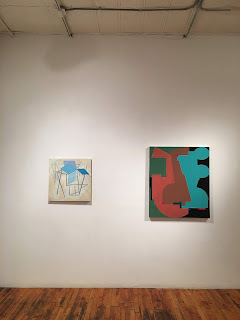 |
I did not expect a show of this exacting caliber, making it all the more wondrous. Official imagery here: Gallery Link
and on Facebook under Theodore:Art. Curated by Stephanie Theodore and Jill Weinberg; the install is amazing. Above, detail from Laurie Fendrich's painting: slow, intense, dense, meticulous.
|
 |
Starting off, the chromatic glow
of near-florescent hues absorbed by packed dirt black stripes by Eric Santoscoy-McKillip provide a visual thesis of sorts for the show. |
 |
| Gary Petersen's ode to mid-century linearity brings lightness to tape and layers rendering canvas another color or texture. |
 |
| The dynamics build quickly and forcefully between works and by the first grouping, the eye is mystified and delighted. |
 |
| Sharon Butler's paintingimbues stripes and geometric shapes with unexpectedly casual facture. A visual aporia results from coalesceing soft and hard elements. |
 |
| Another spectacular grouping, with Richard Kalina's collaged surface bridging the terrain between Butler's frisson and Santiscoy-McKillip's surfaces. |
 |
| It's so smart! We can't really make sense of where we are, yet the decisions from one artist to the next interrelate in all sorts of subtle ways through tactility, edge, color, and shape. |
 |
| The narrative continues. The building blocks of house--line, shape, edge--destabilize in paint, arguing for painting's radicality. |
 |
| Across the room, a jam between Kalina, Butler and Petersen. |
 |
| Butler's off-the-cuff tensions invite delicious problematics for expectations of stability. |
 |
| Kalina's edges softened by facture call or respond to Butler's provisional geometries. |
 |
| Color weaves over surface shifts like a river, binding the works. |
 |
| Butler's four-step painting surface is covered, not true for all her works in this show. Here and elsewhere edges, sometimes painted other times not, shift focus from inside the painting outward. |
 |
| This exhibition challenges us in segments, compositional space that refocus decisions from area to area and question solidity in form and perception. |
No comments:
Post a Comment